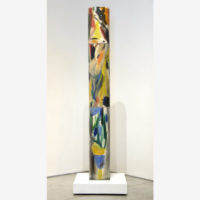ELAINE DE KOONING (1918-1989)
_27843.jpg)
_27843_detail1.jpg)
_27843_detail2.jpg)
_27843_detail3.jpg)
_27843_detail4.jpg)
_27843_detail5.jpg)
_27843_detail6.jpg)
_27843_detail7.jpg)
_27843_detail8.jpg)
_27843_detail9.jpg)
Provenance
Family of Elaine de KooningExhibition
West Palm Beach, Florida, Ann Norton Sculpture Gardens, Discovering Creativity: American Art Masters, January 10 - March 17, 2024Price375,000
History
Mary Gabriel’s brilliant account of the women who stood behind then painted toe to toe with their male counterparts had to end the story at some point. After all, Ninth Street Women is 700 pages long. But its final chapter, appropriately entitled “Epilogue” summaries the next phase of the New York School and Abstract Expressionism as if it died in 1960 when Frank Stella’s rigorously painted canvases in black housepaint set the art world on its ears. Truly, there was more than a seasonal change in the air of Manhattan, but for three women — Joan Mitchell, Helen Frankenthaler, and Elaine de Kooning — nothing could be further from the truth. Much of their best work would come in decades ahead. As for Elaine, by 1957 she had won a hard-fought battle to achieve self-sufficiency. She was free of Willem, had her own car, and as if to emphasize that fait accompli, she traveled west, experienced the color and expanse of the landscape, and tasted the drama and color of the corrida at the Plaza Monumental in Ciudad Juárez, Mexico. Her paintings and drawings were inspired by the dozen bullfights she attended. They are transmutations of that experience; swirling dervishes of color and heart-pounding action. The fervor with which she attacked the canvas or paper support changed forever. Suddenly, here was an artist who lived up to Harold Rosenberg’s ideal when he called the birth of “action painting…an arena in which to act” and stated that what appeared on the canvas “was not a picture but an event.”
MoreMARKET INSIGHTS
- The two highest prices for Elaine de Kooning paintings sold at auction were just set in March 2021, signaling the rising value of works by Elaine
- “Red Bison/Blue Horse” from the 1980s, set a new record for the artist at auction on 9 March 2021, selling for $562,500 USD.
- One week later, an Elaine de Kooning bullfight painting from the late 1950s sold for $428,400 USD, the second-highest auction price for the artist.
- We are seeing artworks by historically undervalued artists such as Elaine de Kooning continue to increase in value.





























